Family: Tenthredinidae
Family common name: common sawflies
Subfamily: Nematinae
Tribe: Nematini
Genus: Nematus Panzer, 1801
Subgenera: none
The Tenthredinidae are the most species-rich family and are found throughout the world, in all continents but Antarctica. They are known as the “common sawflies.” They can generally be recognized by a cylindrical body and long, segmented antennaeantenna:
the sensory organ emerging from the front of the head, usually between the compound eyes and above the clypeus; includes the flagellum, scape and pedicel
 . Otherwise, they come in a variety of colors, sizes, and forms (Goulet 1992Goulet 1992:
. Otherwise, they come in a variety of colors, sizes, and forms (Goulet 1992Goulet 1992:
Goulet H. 1992. The genera and subgenera of the sawflies of Canada and Alaska: Hymenoptera. Symphyta. The insects and arachnids of Canada. Part 20. Agriculture Canada Publication.).
Nematinae is the second-largest subfamily of Tenthredinidae, with over 1,250 species (Prous et al. 2014Prous et al. 2014:
Prous M, Blank SM, Goulet H, Heibo E, Liston A, Malm T, Nyman T, Schmidt S, Smith DR, Varing;rdal H, Viitasaari M, Vikberg V, and Taeger A. 2014. The genera of Nematinae (Hymenoptera, Tenthredinidae). Journal of Hymenoptera Research 40: 1-69. " target="_blank">https://doi.org/10.3897/JHR.40.7442). They are most diverse in northern Eurasia and North America; only a few species occur in the Southern Hemisphere. Nematinae sawflies have a variety of feeding habits including external leaf feeding, leaf mining, and gall forming, and feed on a variety of hosts (Smith 2003bSmith 2003b:
Smith DR. 2003b. A Synopsis of the sawflies (Hymenoptera: Symphyta) of America south of the United States: Tenthredinidae (Nematinae, Heterarthrinae, Tenthredininae). Transactions of the American Entomological Society 129 (1): 1-45.).
The Nematinae have been subject to numerous revisions in recent years. As of 2021, there are no comprehensive keys to many of the North American species of Nematinae (Prous et al. 2014Prous et al. 2014:
Prous M, Blank SM, Goulet H, Heibo E, Liston A, Malm T, Nyman T, Schmidt S, Smith DR, Varing;rdal H, Viitasaari M, Vikberg V, and Taeger A. 2014. The genera of Nematinae (Hymenoptera, Tenthredinidae). Journal of Hymenoptera Research 40: 1-69. " target="_blank">https://doi.org/10.3897/JHR.40.7442). Because of changing taxonomy and extreme variability in morphology, identifying genera and species in the Nematinae may be more challenging than in other subfamilies of Tenthredindae. For this reason, knowing the host or behaviors of a specimen can be extremely helpful for identification within this subfamily.
Nematus is a species-rich and widespread genus. In recent years, the genus Craesus was synonymized with Nematus, and many species have been transferred to the genus Euura. As presently defined, Nematus is somewhat difficult to key based on morphology, and will require further species-level revisions in the future (Prous et al. 2014Prous et al. 2014:
Prous M, Blank SM, Goulet H, Heibo E, Liston A, Malm T, Nyman T, Schmidt S, Smith DR, Varing;rdal H, Viitasaari M, Vikberg V, and Taeger A. 2014. The genera of Nematinae (Hymenoptera, Tenthredinidae). Journal of Hymenoptera Research 40: 1-69. " target="_blank">https://doi.org/10.3897/JHR.40.7442).
Nematus have a variety of colors and forms, but are generally between 3–12 mm in length and mostly black. Five species have distinctly wide hind tarsitarsus:
the fifth and last segment of the leg
 (Prous et al. 2014Prous et al. 2014:
(Prous et al. 2014Prous et al. 2014:
Prous M, Blank SM, Goulet H, Heibo E, Liston A, Malm T, Nyman T, Schmidt S, Smith DR, Varing;rdal H, Viitasaari M, Vikberg V, and Taeger A. 2014. The genera of Nematinae (Hymenoptera, Tenthredinidae). Journal of Hymenoptera Research 40: 1-69. " target="_blank">https://doi.org/10.3897/JHR.40.7442).
There are 127 described species worldwide. Twenty species occur in North America (Taeger et al. 2018Taeger et al. 2018:
Taeger A, Liston AD, Prous M, Groll EK, Gehroldt T, and Blank SM. 2018. ECatSymmdash;Electronic World Catalog of Symphyta (Insecta, Hymenoptera). Program version 5.0 (19 Dec 2018), data version 40 (23 Sep 2018). Senckenberg Deutsches Entomologisches Institut (SDEI), Muuml;ncheberg. https://sdei.de/ecatsym/ Accessed: 28 Jan 2020.).
Incomplete keys to groups of Nematus species are included in Smith 1972bSmith 1972b:
Smith DR. 1972b. Sawflies of the genus Croesus Leach in North America (Hymenoptera: Tenthredinidae). Proceedings of the Entomological Society of Washington 74 (2): 169-180. (as Croesus) and in Smith 2008aSmith 2008a:
Smith DR. 2008a. The abbotii and erythrogaster groups of Nematus Panzer (Hymenoptera: Tenthredinidae) in North America. Proceedings of the Entomological Society of Washington 110 (3): 647-667. (abbotii and erythrogaster groups).
Subfamily characters
 cellcell:
cellcell: 1M slightly constricted apically; veins M and 1m-cu convergent toward the stigmastigma:
1M slightly constricted apically; veins M and 1m-cu convergent toward the stigmastigma: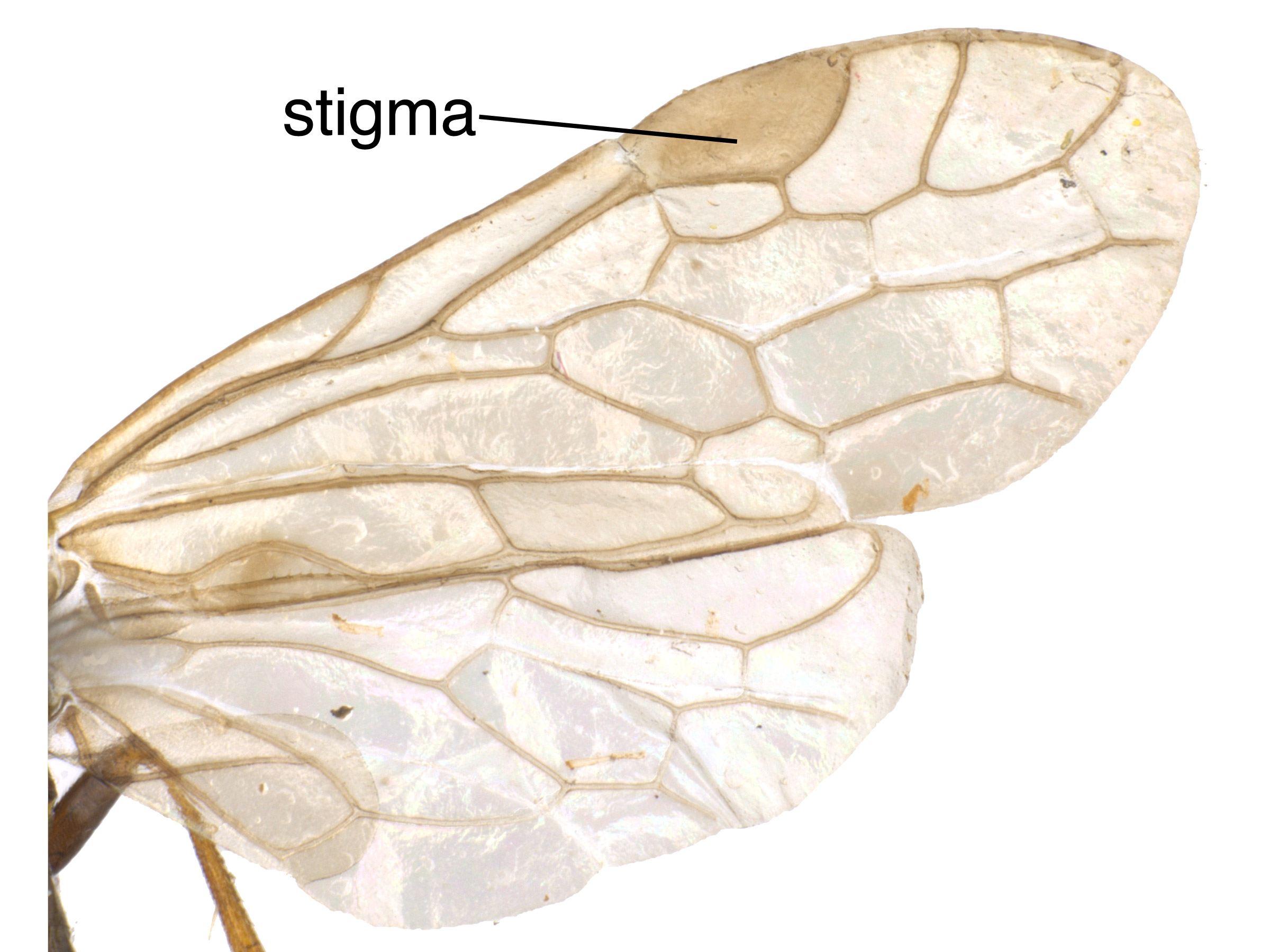 (Goulet 1992Goulet 1992:
(Goulet 1992Goulet 1992: vein 2m-cu meeting cellcell:
vein 2m-cu meeting cellcell: 1Rs above (Prous et al. 2014Prous et al. 2014:
1Rs above (Prous et al. 2014Prous et al. 2014:Genus characters
There are several forms represented in Nematus, so many characters only apply to some species:
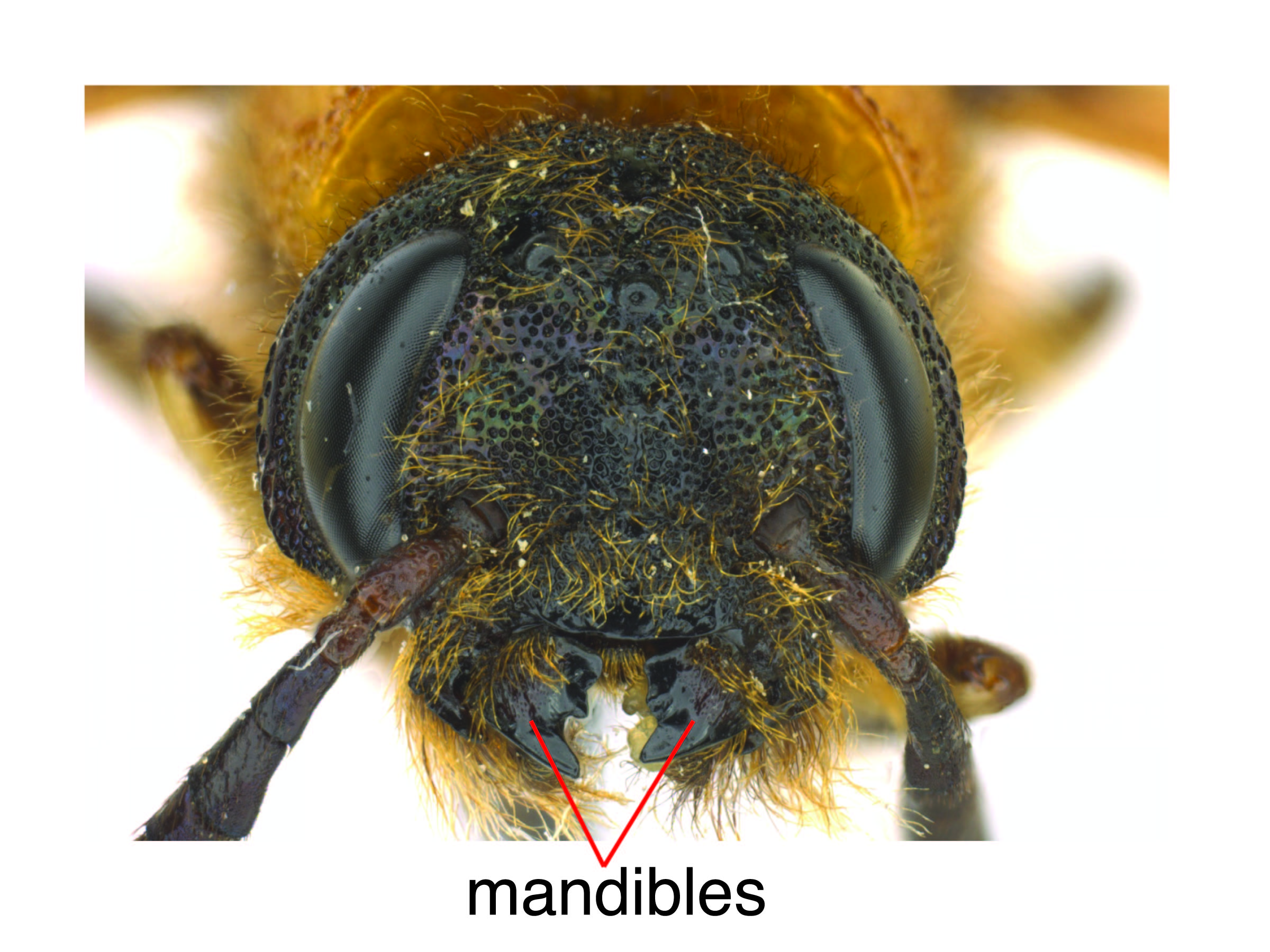 markedly constricted near middle (Prous et al. 2014Prous et al. 2014:
markedly constricted near middle (Prous et al. 2014Prous et al. 2014: deeply emarginated (Prous et al. 2014Prous et al. 2014:
deeply emarginated (Prous et al. 2014Prous et al. 2014: clearly outlined (Prous et al. 2014Prous et al. 2014:
clearly outlined (Prous et al. 2014Prous et al. 2014: veins M and Rs+M relatively widely separated on veinvein:
veins M and Rs+M relatively widely separated on veinvein: R (Goulet 1992Goulet 1992:
R (Goulet 1992Goulet 1992: vein 2A+3A incomplete and straight (Prous et al. 2014Prous et al. 2014:
vein 2A+3A incomplete and straight (Prous et al. 2014Prous et al. 2014: vein 2A meeting 1A; basalbasal:
vein 2A meeting 1A; basalbasal: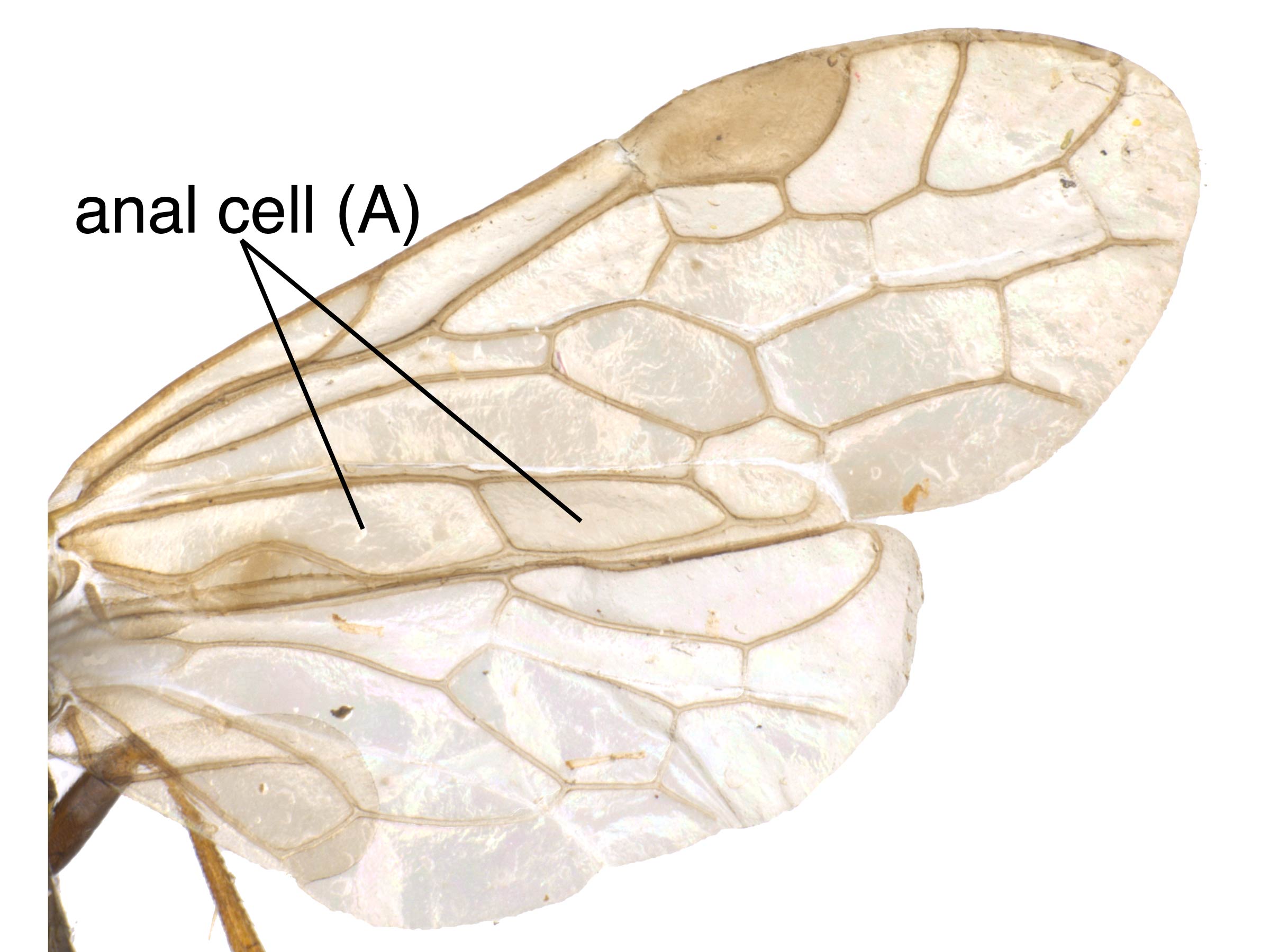 present (Prous et al. 2014Prous et al. 2014:
present (Prous et al. 2014Prous et al. 2014: vein 2r-rs absent (Prous et al. 2014Prous et al. 2014:
vein 2r-rs absent (Prous et al. 2014Prous et al. 2014: vein 2r-m present (Prous et al. 2014Prous et al. 2014:
vein 2r-m present (Prous et al. 2014Prous et al. 2014: with long inner tooth (Prous et al. 2014Prous et al. 2014:
with long inner tooth (Prous et al. 2014Prous et al. 2014: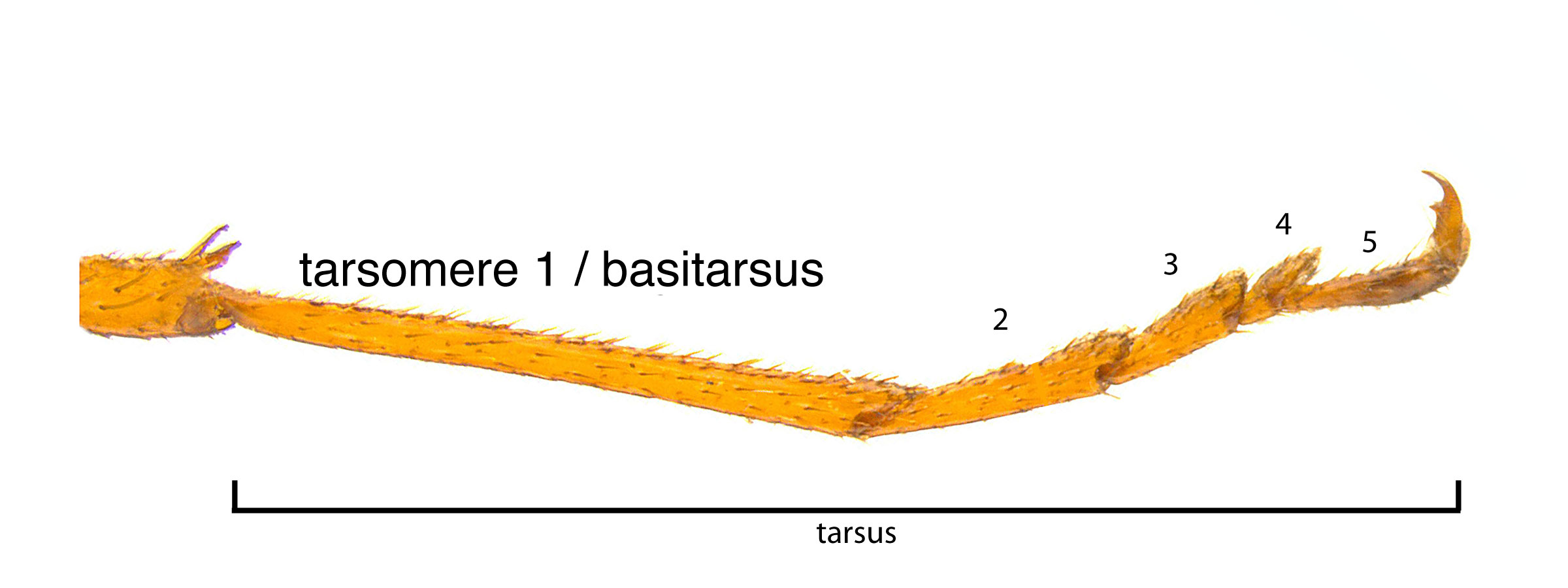 wide, about 2–3X the width of the second hind tarsomeretarsomere:
wide, about 2–3X the width of the second hind tarsomeretarsomere: (Prous et al. 2014Prous et al. 2014:
(Prous et al. 2014Prous et al. 2014: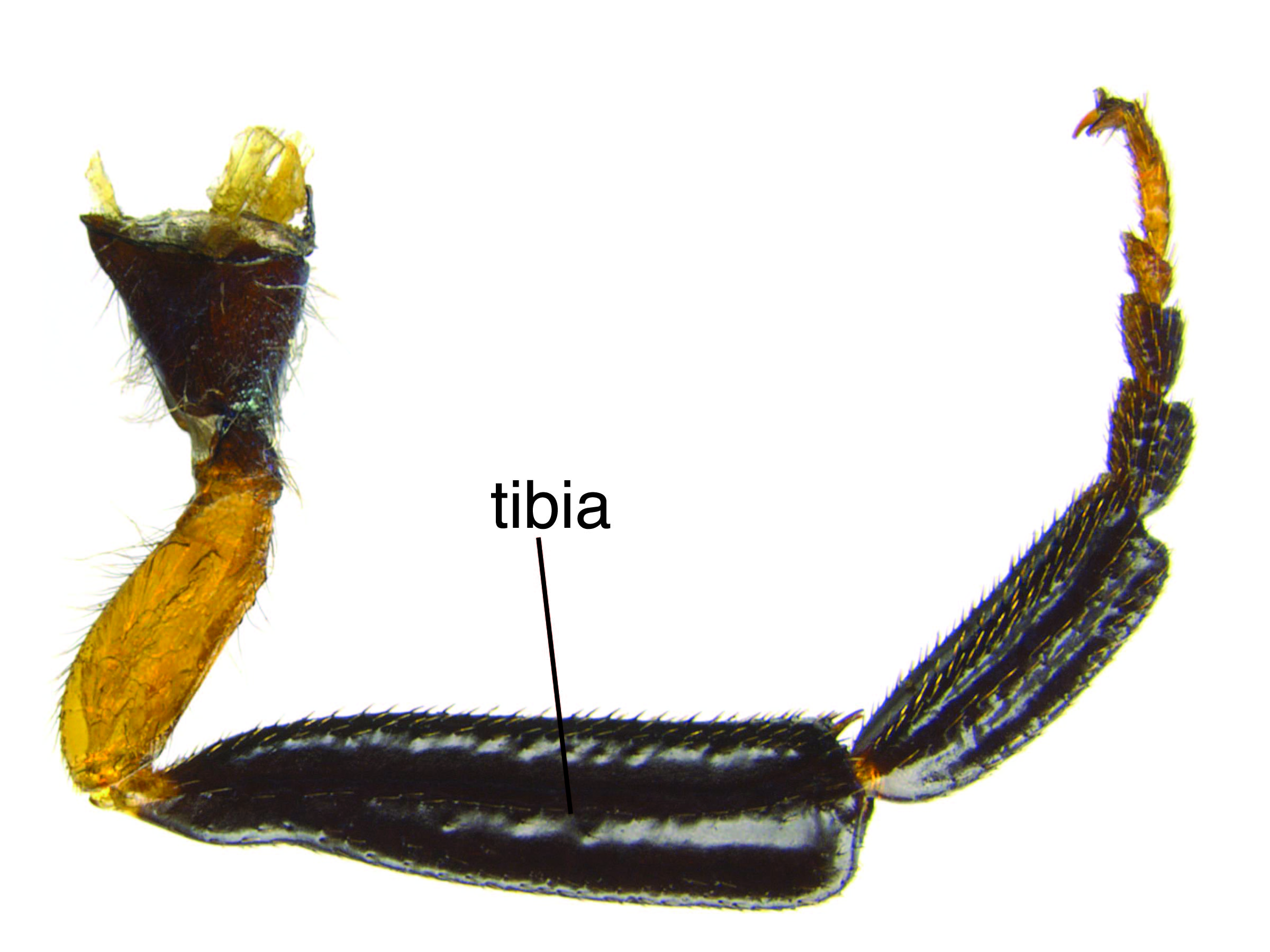 with a longitudinal furrowfurrow:
with a longitudinal furrowfurrow: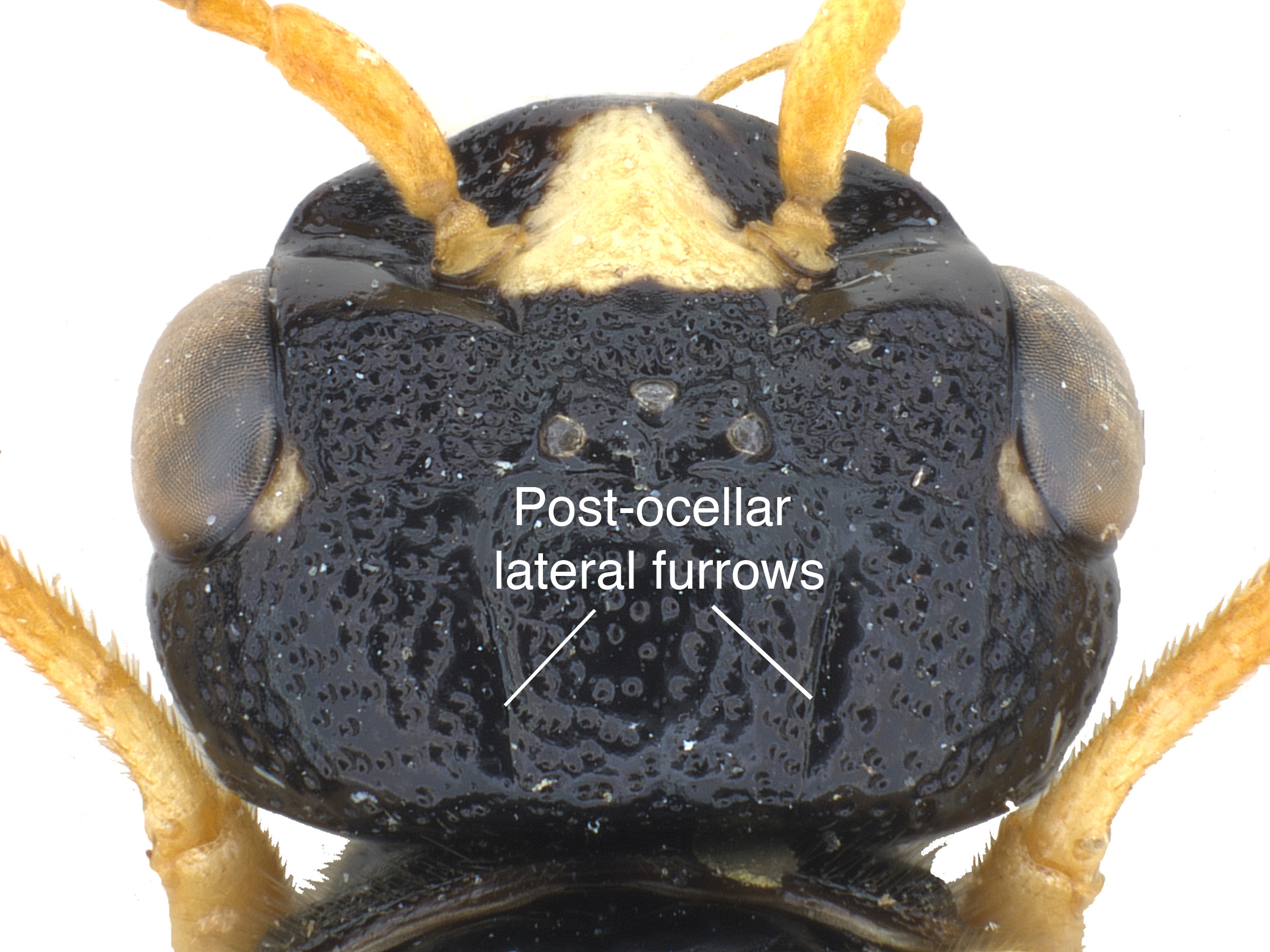 along laterallateral:
along laterallateral:Nematus has several shared morphological characters with Euura and Pristiphora, and in some cases cannot be easily distinguished. Together, these three genera can usually be distinguished from other Nematinae by the lack of fore wingfore wing:
the anterior wing of each pair of wings; usually the largest wing of the pair
 vein 2r-rs, incomplete veinvein:
vein 2r-rs, incomplete veinvein:
a tube-like, often darkened, structure on the wings
 2A+3A, and asymmetrical outer surfaces of the mandibles. Euura and Nematus can usually be distinguished from Pristiphora by the evenly tapering ovipositorovipositor:
2A+3A, and asymmetrical outer surfaces of the mandibles. Euura and Nematus can usually be distinguished from Pristiphora by the evenly tapering ovipositorovipositor:
the female organ that deposits eggs and is used to drill into plant tissue, located at the apex of the abdomen, made up of the lance and lancet
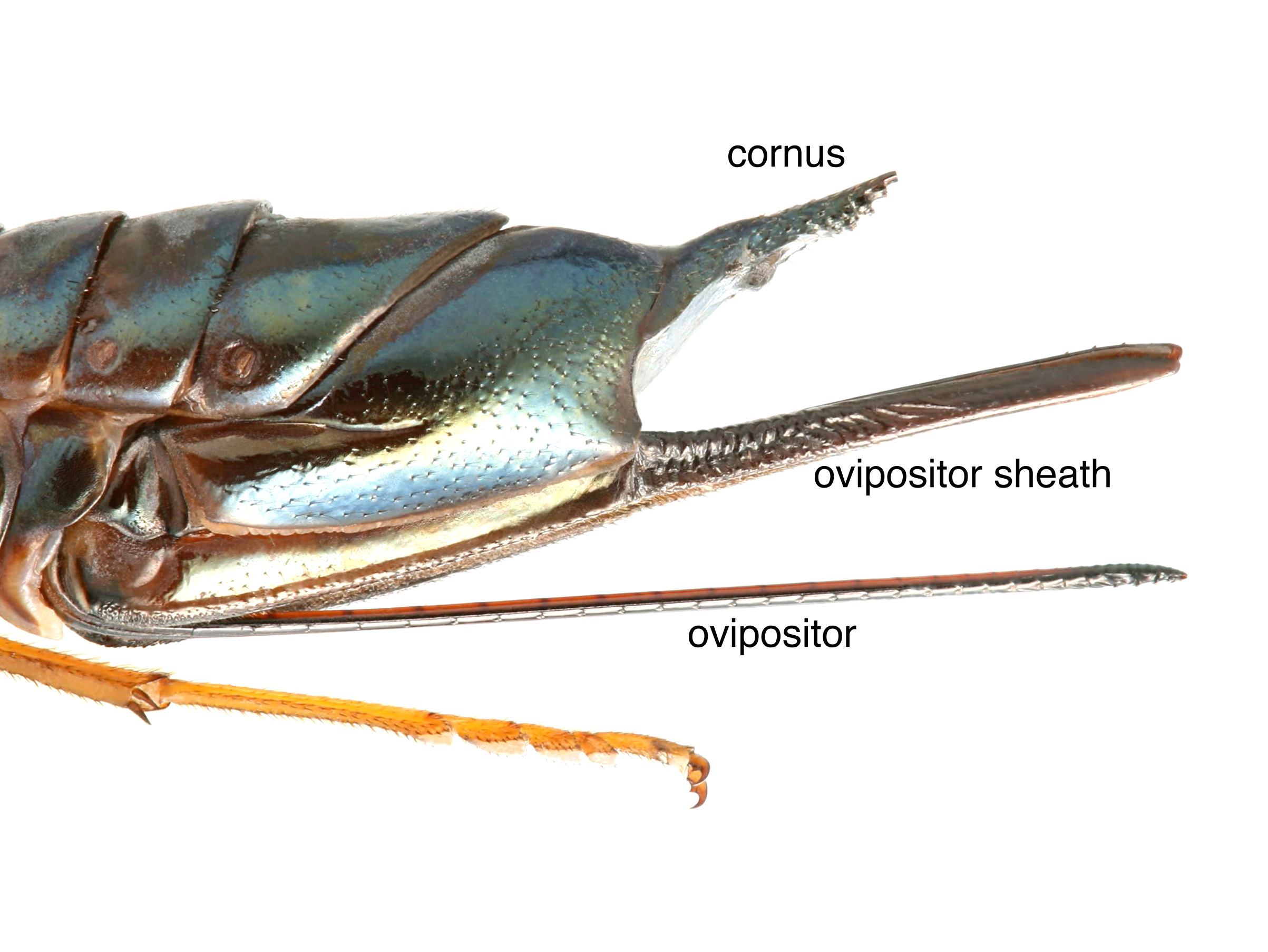 sheath, long subapical tooth of the tarsal clawtarsal claw:
sheath, long subapical tooth of the tarsal clawtarsal claw:
sharpened appendage emerging from the apex of the tarsus
 , emarginated clypeusclypeus:
, emarginated clypeusclypeus:
sclerotized area on the front of the head located between the antennal insertions and labrum
 , and fore wingfore wing:
, and fore wingfore wing:
the anterior wing of each pair of wings; usually the largest wing of the pair
 vein C not enlarged apically (Prous et al. 2014Prous et al. 2014:
vein C not enlarged apically (Prous et al. 2014Prous et al. 2014:
Prous M, Blank SM, Goulet H, Heibo E, Liston A, Malm T, Nyman T, Schmidt S, Smith DR, Varing;rdal H, Viitasaari M, Vikberg V, and Taeger A. 2014. The genera of Nematinae (Hymenoptera, Tenthredinidae). Journal of Hymenoptera Research 40: 1-69. " target="_blank">https://doi.org/10.3897/JHR.40.7442). Some species of Nematus are easily recognized by the distinctly widened hind tarsustarsus:
the fifth and last segment of the leg
 (Prous et al. 2014Prous et al. 2014:
(Prous et al. 2014Prous et al. 2014:
Prous M, Blank SM, Goulet H, Heibo E, Liston A, Malm T, Nyman T, Schmidt S, Smith DR, Varing;rdal H, Viitasaari M, Vikberg V, and Taeger A. 2014. The genera of Nematinae (Hymenoptera, Tenthredinidae). Journal of Hymenoptera Research 40: 1-69. " target="_blank">https://doi.org/10.3897/JHR.40.7442)
Nematus prunivorous is a bivoltinebivoltine:
describing a life cycle with two generations per calendar year
, serious pest of apricot trees in China (Gangrou 1995Gangrou 1995:
Gangrou X. 1995. A new species of the genus Nematus (Hymenoptera: Tenthredinidae) from China. Forest Research 8 (5): 497-499.).
Nematus feeds on a variety of hosts, including but not limited to species of Salix (willow), Populus (poplar, cottonwood), Betula (birch), Corylus (hazel), Castanea (chestnut), Robinia (locust), Ostrya (hophornbeam), Hamamelis (witch hazel), and Alnus (alder) (Smith 1972bSmith 1972b:
Smith DR. 1972b. Sawflies of the genus Croesus Leach in North America (Hymenoptera: Tenthredinidae). Proceedings of the Entomological Society of Washington 74 (2): 169-180., Smith 2003bSmith 2003b:
Smith DR. 2003b. A Synopsis of the sawflies (Hymenoptera: Symphyta) of America south of the United States: Tenthredinidae (Nematinae, Heterarthrinae, Tenthredininae). Transactions of the American Entomological Society 129 (1): 1-45., Smith 2008aSmith 2008a:
Smith DR. 2008a. The abbotii and erythrogaster groups of Nematus Panzer (Hymenoptera: Tenthredinidae) in North America. Proceedings of the Entomological Society of Washington 110 (3): 647-667.).
Females generally oviposit along the midribs of leaves (Smith 2008aSmith 2008a:
Smith DR. 2008a. The abbotii and erythrogaster groups of Nematus Panzer (Hymenoptera: Tenthredinidae) in North America. Proceedings of the Entomological Society of Washington 110 (3): 647-667.). LarvaeLarva:
the immature stage of holometabolous insects
 are external feeders on leaves of the host (Smith 2003bSmith 2003b:
are external feeders on leaves of the host (Smith 2003bSmith 2003b:
Smith DR. 2003b. A Synopsis of the sawflies (Hymenoptera: Symphyta) of America south of the United States: Tenthredinidae (Nematinae, Heterarthrinae, Tenthredininae). Transactions of the American Entomological Society 129 (1): 1-45.), sometimes gregariously, sometimes singly. At maturity, the larvaelarva:
the immature stage of holometabolous insects
 fall to the ground and spin cocoons in which they pupate or overwinter. The number of generations per year varies among species (Smith 2008aSmith 2008a:
fall to the ground and spin cocoons in which they pupate or overwinter. The number of generations per year varies among species (Smith 2008aSmith 2008a:
Smith DR. 2008a. The abbotii and erythrogaster groups of Nematus Panzer (Hymenoptera: Tenthredinidae) in North America. Proceedings of the Entomological Society of Washington 110 (3): 647-667.).
World: The genus is known from North America, throughout Europe, and throughout most of Asia, including India, Myanmar, Iran, Kyrgyzstan, Korea, China, and Japan (Taeger et al. 2018Taeger et al. 2018:
Taeger A, Liston AD, Prous M, Groll EK, Gehroldt T, and Blank SM. 2018. ECatSymmdash;Electronic World Catalog of Symphyta (Insecta, Hymenoptera). Program version 5.0 (19 Dec 2018), data version 40 (23 Sep 2018). Senckenberg Deutsches Entomologisches Institut (SDEI), Muuml;ncheberg. https://sdei.de/ecatsym/ Accessed: 28 Jan 2020.).
North America: Nematus occurs thoughout the United States and Canada, and in Alaska (Taeger et al. 2018Taeger et al. 2018:
Taeger A, Liston AD, Prous M, Groll EK, Gehroldt T, and Blank SM. 2018. ECatSymmdash;Electronic World Catalog of Symphyta (Insecta, Hymenoptera). Program version 5.0 (19 Dec 2018), data version 40 (23 Sep 2018). Senckenberg Deutsches Entomologisches Institut (SDEI), Muuml;ncheberg. https://sdei.de/ecatsym/ Accessed: 28 Jan 2020.). Two species, N. iridescens and N. mexicanus, occur farther south into Mexico, in Baja California Norte and Sonora, respectively (Smith 2003bSmith 2003b:
Smith DR. 2003b. A Synopsis of the sawflies (Hymenoptera: Symphyta) of America south of the United States: Tenthredinidae (Nematinae, Heterarthrinae, Tenthredininae). Transactions of the American Entomological Society 129 (1): 1-45.).
Map data from: GBIF.org (29 October 2019) GBIF Occurrence Download Nematus
Details about data used for maps can be found here.